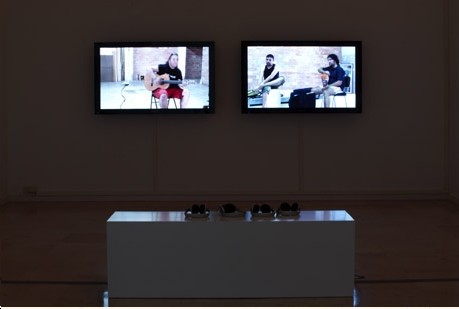Montserrat Soto
13 Nov 2008 - 10 Jan 2009
MONTSERRAT SOTO
"Datos primitivos"
For her latest show at Galería Helga de Alvear, Monserrat Soto dissects artists’ creative processes in two video works.
In “Lugares de silencio”, the first of the two, the poet Dionisio Cañas inhabits a physical and at once mythical space as he searches for the exact word. His physical location is on the other side of a wall, in a space we imagine to be labyrinthine though we have no access to it. We know he is there because of his voice, because of the omniscient recital and, from time to time, we catch fleeting glimpses of him though a kind of grille in the wall.
The poet wanders through the space, rambling around as if his physical movements were a kind of translation of mental paths. As if, in walking, he could reproduce the paths his mind takes as it searches, explores and tries out different possibilities until he comes up with the precise word required to complete the poem. The spectator is thus given an insight into the secret of creation; it is almost like observing the artist in his place of work. Only that the true place of work of an artist is in his mind.
Montserrat Soto represents this mythical space of creation as a labyrinth whose paths we cannot altogether understand. However much we might intuit them, they are totally inaccessible to us. Yet it is also a closed place, almost like a prison from which the artist himself cannot find his way out.
Cut off from the rest of the world, beyond the wall and the grille there is a place we can imagine, where the magic of the process of creation takes place.
The creative process in “Dato primitivo 2” is not only individual but also collective as the artist has to communicate his creative act to others, to the other. This time, we see the musician Chico Ocaña preparing his latest album. After first composing his new songs on his own, it is now time to work with the musicians he is going to record with. He has to transmit what he has already created, to explain to the others what he has imagined in his head. Each note, each arrangement, each variation, has to be transmitted outside himself, outside his interior, with the added difficulty that music is the most abstract and intangible of the arts.
Moments when the composer and the musicians return once and again to what they have created are contrasted, counterpoised and repeated on two parallel screens. It is a process of transmission but also of filtering and subtle nuances. With each clarification and explanation the work of art is gradually defined and given shape, being transformed from the simple humming of the composer into the shared execution of the whole group. From creation to transmission and public execution. From the solitude of the creator to the multitude of the spectator.
"Datos primitivos"
For her latest show at Galería Helga de Alvear, Monserrat Soto dissects artists’ creative processes in two video works.
In “Lugares de silencio”, the first of the two, the poet Dionisio Cañas inhabits a physical and at once mythical space as he searches for the exact word. His physical location is on the other side of a wall, in a space we imagine to be labyrinthine though we have no access to it. We know he is there because of his voice, because of the omniscient recital and, from time to time, we catch fleeting glimpses of him though a kind of grille in the wall.
The poet wanders through the space, rambling around as if his physical movements were a kind of translation of mental paths. As if, in walking, he could reproduce the paths his mind takes as it searches, explores and tries out different possibilities until he comes up with the precise word required to complete the poem. The spectator is thus given an insight into the secret of creation; it is almost like observing the artist in his place of work. Only that the true place of work of an artist is in his mind.
Montserrat Soto represents this mythical space of creation as a labyrinth whose paths we cannot altogether understand. However much we might intuit them, they are totally inaccessible to us. Yet it is also a closed place, almost like a prison from which the artist himself cannot find his way out.
Cut off from the rest of the world, beyond the wall and the grille there is a place we can imagine, where the magic of the process of creation takes place.
The creative process in “Dato primitivo 2” is not only individual but also collective as the artist has to communicate his creative act to others, to the other. This time, we see the musician Chico Ocaña preparing his latest album. After first composing his new songs on his own, it is now time to work with the musicians he is going to record with. He has to transmit what he has already created, to explain to the others what he has imagined in his head. Each note, each arrangement, each variation, has to be transmitted outside himself, outside his interior, with the added difficulty that music is the most abstract and intangible of the arts.
Moments when the composer and the musicians return once and again to what they have created are contrasted, counterpoised and repeated on two parallel screens. It is a process of transmission but also of filtering and subtle nuances. With each clarification and explanation the work of art is gradually defined and given shape, being transformed from the simple humming of the composer into the shared execution of the whole group. From creation to transmission and public execution. From the solitude of the creator to the multitude of the spectator.

